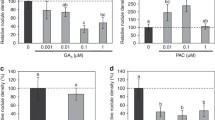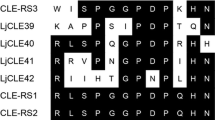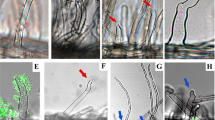Abstract
Legumes engage in symbiosis with nitrogen-fixing soil bacteria, collectively called rhizobia, under nitrogen-limited conditions. In many legumes, the root invasion of rhizobia is mediated by infection threads (ITs), tubular invaginations of the host cell wall and plasma membrane, developed from infection foci of deformed root hairs. IT formation is regulated by a series of signal transduction in host root. Nodulation signals activate the host transcription factor (TF), CYCLOPS, which directly induces expression of two TF genes, ERF REQUIRED FOR NODULATION1 (ERN1) and NODULE INCEPTION (NIN), essential for IT development. Here, we explored the relationship among these three symbiotic TF genes in the model legume Lotus japonicus and examined how their interplay contributes to IT formation. qRT-PCR analysis showed that NIN expression induced by rhizobial infection was attenuated in ern1-1, and further declined in cyclops-3 ern1-1. ERN1 overexpression led to induction of NIN expression in cyclops-3 ern1-1 in the presence of rhizobia. Thus, in addition to CYCLOPS, ERN1 is able to increase the NIN expression level depending on infection. Furthermore, consistent with this transcriptional hierarchy, ectopic expression of ERN1 as well as NIN suppressed the IT-deficient cyclops-3 phenotype, but ERN1 failed to confer ITs in the nin-2 root. However, the ern1-1 symbiotic epidermal phenotype was not suppressed by the NIN ectopic expression. The cyclops-3 ern1-1 double mutant was less sensitive to rhizobial infection than the single mutants and defective in the symbiotic root hair response at earlier stages. This more severe phenotype of the double mutant suggests a role for ERN1 that independent of the CYCLOPS-mediated transcriptional regulation. We conclude that ERN1 is involved in regulating NIN expression in addition to CYCLOPS, and these TFs coordinately promote the symbiotic root hair response and IT development. Our data help to reveal the extensive role of ERN1 in root nodule symbiosis signaling.





Similar content being viewed by others
Abbreviations
- 6-BA:
-
6-benzylaminopurine
- CCaMK:
-
Calcium and calmodulin-dependent protein kinase
- ERN1:
-
ERF REQUIRED FOR NODULATION1
- IPD3:
-
INTERACTING PROTEIN OF DMI3
- IT:
-
INFECTION THREAD
- MC:
-
Micro-colony
- NIN:
-
NODULE INCEPTION
- NFR:
-
Nod factor receptor
- NSP:
-
NODULATION SIGNALING PATHWAY
- qRT-PCR:
-
Quantitative real-time PCR
- TF:
-
Transcription factor
- WT:
-
Wild type
References
Amor BB, Shaw SL, Oldroyd GED, Maillet F, Penmetsa RV, Cook D et al (2003) The NFP locus of Medicago truncatula controls an early step of Nod factor signal transduction upstream of a rapid calcium flux and root hair deformation. Plant J 34:495–506. https://doi.org/10.1046/j.1365-313X.2003.01743.x
Andriankaja WA, Boisson-Dernier A, Frances L, Sauviac L, Jauneau A, Barker DG et al (2007) AP2-ERF transcription factors mediate Nod factor-dependent MtENOD11 activation in root hairs via a novel cis-regulatory motif. Plant Cell 19:2866–2885. https://doi.org/10.1105/tpc.107.052944
Ardourel M, Demont N, Debellé F, Maillet F, De Billy F, Promé JC et al (1994) Rhizobium meliloti lipooligosaccharide nodulation factors: different structural requirements for bacterial entry into target root hair cells and induction of plant symbiotic developmental responses. Plant Cell 6:1357–1374. https://doi.org/10.1105/tpc.6.10.1357
Broughton WJ, Dilworth MJ (1971) Control of leghaemoglobin synthesis in snake beans. Biochem J 125:1075–1080. https://doi.org/10.1042/bj1251075
Catoira R, Galera C, de Billy F, Penmetsa RV, Journet EP, Maillet F et al (2000) Four genes of Medicago truncatula controlling components of a Nod factor transduction pathway. Plant Cell 12:1647–1666. https://doi.org/10.1105/TPC.12.9.1647
Cerri MR, Frances L, Kelner A, Fournier J, Middleton PH, Auriac MC et al (2016) The symbiosis-related ERN transcription factors act in concert to coordinate rhizobial host root infection. Plant Physiol 171:1037–1054. https://doi.org/10.1104/pp.16.00230
Cerri MR, Wang Q, Stolz P, Folgmann J, Frances L, Katzer K et al (2017) The ERN1 transcription factor gene is a target of the CCaMK/CYCLOPS complex and controls rhizobial infection in Lotus japonicus. New Phytol 215:323–337. https://doi.org/10.1111/nph.14547
Ehrhardt DW, Wais R, Long SR (1996) Calcium spiking in plant root hairs responding to rhizobium nodulation signals. Cell 85:673–681. https://doi.org/10.1016/S0092-8674(00)81234-9
Fisher RF, Long SR (1992) Rhizobium-plant signal exchange. Nature 357:655–660. https://doi.org/10.1038/357655a0
Floss DS, Gomez SK, Park HJ, MacLean AM, Müller LM, Bhattarai KK et al (2017) A transcriptional program for arbuscule degeneration during AM symbiosis is regulated by MYB1. Curr Biol 27:1206–1212. https://doi.org/10.1016/j.cub.2017.03.003
Fonouni-Farde C, Tan S, Baudin M, Brault M, Wen J, Mysore KS et al (2016) DELLA-mediated gibberellin signalling regulates Nod factor signalling and rhizobial infection. Nat Commun 7:12636. https://doi.org/10.1038/ncomms12636
Guinel FC, Geil RD (2002) A model for the development of the rhizobial and arbuscular mycorrhizal symbioses in legumes and its use to understand the roles of ethylene in the establishment of these two symbioses. Can J Bot 80:695–720. https://doi.org/10.1139/B02-066
Hayashi T, Banba M, Shimoda Y, Kouchi H, Hayashi M, Imaizumi-Anraku H (2010) A dominant function of CCaMK in intracellular accommodation of bacterial and fungal endosymbionts. Plant J 63:141–154. https://doi.org/10.1111/j.1365-313X.2010.04228.x
Heckmann AB, Lombardo F, Miwa H, Perry JA, Bunnewell S, Parniske M et al (2006) Lotus japonicus nodulation requires two GRAS domain regulators, one of which is functionally conserved in a non-legume. Plant Physiol 142:1739–1750. https://doi.org/10.1104/pp.106.089508
Heckmann AB, Sandal N, Bek AS, Madsen LH, Jurkiewicz A, Nielsen MW et al (2011) Cytokinin induction of root nodule primordia in Lotus japonicus is regulated by a mechanism operating in the root cortex. Mol Plant Microbe Interact 24:1385–1395. https://doi.org/10.1094/MPMI-05-11-0142
Hirsch S, Kim J, Munoz A, Heckmann AB, Downie JA, Oldroyd GED (2009) GRAS proteins form a DNA binding complex to induce gene expression during nodulation signaling in Medicago truncatula. Plant Cell 21:545–557. https://doi.org/10.1105/tpc.108.064501
Jin Y, Liu H, Luo D, Yu N, Dong W, Wang C et al (2016) DELLA proteins are common components of symbiotic rhizobial and mycorrhizal signalling pathways. Nat Commun 7:12433. https://doi.org/10.1038/ncomms12433
Journet EP, El-Gachtouli N, Vernoud V, de Billy F, Pichon M, Dedieu A et al (2001) Medicago truncatula ENOD11: a novel RPRP-encoding early nodulin gene expressed during mycorrhization in arbuscule-containing cells. Mol Plant Microbe Interact 14:737–748. https://doi.org/10.1094/MPMI.2001.14.6.737
Kaló P, Gleason C, Edwards A, Marsh J, Mitra RM, Hirsch S et al (2005) Nodulation signaling in legumes requires NSP2, a member of the GRAS family of transcriptional regulators. Science 308:1786–1789. https://doi.org/10.1126/science.1110951
Kawaguchi M, Imaizumi-Anraku H, Koiwa H, Niwa S, Ikuta A, Syono K et al (2002) Root, root hair, and symbiotic mutants of the model legume Lotus japonicus. Mol Plant Microbe Interact 15:17–26. https://doi.org/10.1094/MPMI.2002.15.1.17
Kawaharada Y, Kelly S, Nielsen MW, Hjuler CT, Gysel K, Muszyńsk A et al (2015) Receptor-mediated exopolysaccharide perception controls bacterial infection. Nature 523:308–312. https://doi.org/10.1038/nature14611
Kawaharada Y, Nielsen MW, Kelly S, James EK, Andersen KR, Rasmussen SR et al (2017a) Differential regulation of the Epr3 receptor coordinates membrane-restricted rhizobial colonization of root nodule primordia. Nat Commun 8:14534. https://doi.org/10.1038/ncomms14534
Kawaharada Y, James EK, Kelly S, Sandal N, Stougaard J (2017b) The ERF Required for Nodulation1 (ERN1) transcription factor is required for infection thread formation in Lotus japonicus. Mol Plant Microbe Interact 30:194–204. https://doi.org/10.1094/MPMI-11-16-0237-R
Lévy J, Bres C, Geurts R, Chalhoub B, Kulikova O, Duc G et al (2004) A putative Ca2+ and calmodulin-dependent protein kinase required for bacterial and fungal symbioses. Science 303:1361–1364. https://doi.org/10.1126/science.1093038
Limpens E, Franken C, Smit P, Willemse J, Bisseling T, Geurts R (2003) LysM domain receptor kinases regulating rhizobial Nod factor. Science 302:630–634. https://doi.org/10.1126/science.1090074
Liu CW, Breakspear A, Guan D, Cerri MR, Jackson K, Jiang S et al (2019) NIN acts as a network hub controlling a growth module required for rhizobial infection. Plant Physiol 179:1704–1722. https://doi.org/10.1104/pp.18.01572
Madsen EB, Madsen LH, Radutoiu S, Olbryt M, Rakwalska M, Szczyglowski K et al (2003) A receptor kinase gene of the LysM type is involved in legume perception of rhizobial signals. Nature 425:637–640. https://doi.org/10.1038/nature02045
Madsen LH, Tirichine L, Jurkiewicz A, Sullivan JT, Heckmann AB, Bek AS et al (2010) The molecular network governing nodule organogenesis and infection in the model legume Lotus japonicus. Nat Commun 1:1–12. https://doi.org/10.1038/ncomms1009
Maekawa T, Kusakabe M, Shimoda Y, Sato S, Tabata S, Murooka Y et al (2008) Polyubiquitin promoter-based binary vectors for overexpression and gene silencing in Lotus japonicus. Mol Plant Microbe Interact 21:375–382. https://doi.org/10.1094/MPMI-21-4-0375
Maekawa T, Maekawa-Yoshikawa M, Takeda N, Imaizumi-Anraku H, Murooka Y, Hayashi M (2009) Gibberellin controls the nodulation signaling pathway in Lotus japonicus. Plant J 58:183–194. https://doi.org/10.1111/j.1365-313X.2008.03774.x
Małolepszy A, Mun T, Sandal N, Gupta V, Dubin M, Urbański D et al (2016) The LORE1 insertion mutant resource. Plant J 88:306–317. https://doi.org/10.1111/tpj.13243
Marsh JF, Rakocevic A, Mitra RM, Brocard L, Sun J, Eschstruth A et al (2007) Medicago truncatula NIN is essential for rhizobial-independent nodule organogenesis induced by autoactive calcium/calmodulin-dependent protein kinase. Plant Physiol 144:324–335. https://doi.org/10.1104/pp.106.093021
Messinese E, Mun JH, Yeun LH, Jayaraman D, Rougé P, Barre A et al (2007) A novel nuclear protein interacts with the symbiotic DMI3 calcium- and calmodulin-dependent protein kinase of Medicago truncatula. Mol Plant Microbe Interact 20:912–921. https://doi.org/10.1094/MPMI-20-8-0912
Middleton PH, Jakab J, Penmetsa RV, Starker CG, Doll J, Kaló P et al (2007) An ERF transcription factor in Medicago truncatula that is essential for Nod Factor signal transduction. Plant Cell 19:1221–1234. https://doi.org/10.1105/tpc.106.048264
Miller DD, De Ruijter NCA, Bisseling T, Emons AMC (1999) The role of actin in root hair morphogenesis: studies with lipochito-oligosaccharide as a growth stimulator and cytochalasin as an actin perturbing drug. Plant J 17:141–154. https://doi.org/10.1046/j.1365-313X.1999.00358.x
Miwa H, Sun J, Oldroyd GED, Downie JA (2006) Analysis of Nod-factor-induced calcium signaling in root hairs of symbiotically defective mutants of Lotus japonicus. Mol Plant Microbe Interact 19:914–923. https://doi.org/10.1094/MPMI-19-0914
Murakami E, Cheng J, Gysel K, Bozsoki Z, Kawaharada Y, Hjuler CT et al (2018) Epidermal LysM receptor ensures robust symbiotic signalling in Lotus japonicus. Elife 7:e33506. https://doi.org/10.7554/eLife.33506
Murray JD, Karas BJ, Sato S, Tabata S, Amyot L, Szczyglowski K (2007) A cytokinin perception mutant colonized by rhizobium in the absence of nodule organogenesis. Science 315:101–104. https://doi.org/10.1126/science.1132514
Oldroyd GED (2013) Speak, friend, and enter: signalling systems that promote beneficial symbiotic associations in plants. Nat Rev Microbiol 11:252–263. https://doi.org/10.1038/nrmicro2990
Oldroyd GED, Long SR (2003) Identification and characterization of Nodulation-Signaling Pathway 2, a gene of Medicago truncatula involved in Nod actor signaling. Plant Physiol 131:1027–1032. https://doi.org/10.1104/pp.102.010710
Ott T, van Dongen JT, Gunther C, Krusell L, Desbrosses G, Vigeolas H et al (2005) Symbiotic leghemoglobins are crucial for nitrogen fixation in legume root nodules but not for general plant growth and development. Curr Biol 15:531–535. https://doi.org/10.1016/J.CUB.2005.01.042
Pimprikar P, Carbonnel S, Paries M, Katzer K, Klingl V, Bohmer MJ et al (2016) A CCaMK-CYCLOPS-DELLA complex activates transcription of RAM1 to regulate arbuscule branching. Curr Biol 26:987–998. https://doi.org/10.1016/j.cub.2016.01.069
Plet J, Wasson A, Ariel F, Le Signor C, Baker D, Mathesius U et al (2011) MtCRE1-dependent cytokinin signaling integrates bacterial and plant cues to coordinate symbiotic nodule organogenesis in Medicago truncatula. Plant J 65:622–633. https://doi.org/10.1111/j.1365-313X.2010.04447.x
Popp C, Ott T (2011) Regulation of signal transduction and bacterial infection during root nodule symbiosis. Curr Opin Plant Biol 14:458–467. https://doi.org/10.1016/j.pbi.2011.03.016
Qiu L, Lin J, Xu J, Sato S, Parniske M, Wang TL et al (2015) SCARN a novel class of SCAR protein that is required for root-hair infection during legume nodulation. PLoS Genet 11:e1005623. https://doi.org/10.1371/journal.pgen.1005623
Radutoiu S, Madsen LH, Madsen EB, Felle HH, Umehara Y, Grønlund M et al (2003) Plant recognition of symbiotic bacteria requires two LysM receptor-like kinases. Nature 425:585–592. https://doi.org/10.1038/nature02039
Sandal N, Petersen TR, Murray J, Umehara Y, Karas B, Yano K et al (2006) Genetics of symbiosis in Lotus japonicus: recombinant inbred lines, comparative genetic maps, and map position of 35 symbiotic loci. Mol Plant Microbe Interact 19:80–91. https://doi.org/10.1094/MPMI-19-0080
Schauser L, Roussis A, Stiller J, Stougaard J (1999) A plant regulator controlling development of symbiotic root nodules. Nature 402:191–195. https://doi.org/10.1038/46058
Singh S, Katzer K, Lambert J, Cerri M, Parniske M (2014) CYCLOPS, A DNA-binding transcriptional activator, orchestrates symbiotic root nodule development. Cell Host Microbe 15:139–152. https://doi.org/10.1016/j.chom.2014.01.011
Smit P, Raedts J, Portyanko V, Debellé F, Gough C, Bisseling T (2005) NSP1 of the GRAS protein family is essential for rhizobial Nod factor-induced transcription. Science 308:1789–1791. https://doi.org/10.1126/science.1111025
Soyano T, Kouchi H, Hirota A, Hayashi M (2013) NODULE INCEPTION directly targets NF-Y subunit genes to regulate essential processes of root nodule development in Lotus japonicus. PLoS Genet 9:e1003352. https://doi.org/10.1371/journal.pgen.1003352
Soyano T, Hirakawa H, Sato S, Hayashi M, Kawaguchi M (2014) NODULE INCEPTION creates a long-distance negative feedback loop involved in homeostatic regulation of nodule organ production. Proc Natl Acad Sci 111:14607–14612. https://doi.org/10.1073/pnas.1412716111
Tirichine L, Imaizumi-Anraku H, Yoshida S, Murakami Y, Madsen LH, Miwa H et al (2006) Deregulation of a Ca2+/calmodulin-dependent kinase leads to spontaneous nodule development. Nature 441:1153–1156. https://doi.org/10.1038/nature04862
Vernié T, Kim J, Frances L, Ding Y, Sun J, Guan D et al (2015) The NIN transcription factor coordinates diverse nodulation programs in different tissues of the Medicago truncatula root. Plant Cell 27:3410–3424. https://doi.org/10.1105/tpc.15.00461
Xie F, Murray JD, Kim J, Heckmann AB, Edwards A, Oldroyd GED et al (2012) Legume pectate lyase required for root infection by rhizobia. Proc Natl Acad Sci USA 109:633–638. https://doi.org/10.1073/pnas.1113992109
Yano K, Yoshida S, Müller J, Singh S, Banba M, Vickers K et al (2008) CYCLOPS, a mediator of symbiotic intracellular accommodation. Proc Natl Acad Sci USA 105:20540–20545. https://doi.org/10.1073/pnas.0806858105
Yano K, Aoki S, Liu M, Umehara Y, Suganuma N, Iwasaki W et al (2017) Function and evolution of a Lotus japonicus AP2/ERF family transcription factor that is required for development of infection threads. DNA Res 24:193–203. https://doi.org/10.1093/dnares/dsw052
Acknowledgements
We thank Dr. Emiko Yoro in Rikkyo Univeisity for her advice on the manuscript. And we thank A.T., the National Institute for Basic Biology’s Functional Genomics Facility and Model Plant Research Facility for technical supports. This work was supported by Ministry of Education, Culture, Sports, Science and Technology Grants-in-Aid for Scientific Research [Grant numbers 22128006, 17H03702 to M.K.]; and Sumitomo Foundation Grant for Basic Science Research [150574 to T.S.]. This work was also supported in part by SOKENDAI (The Graduate University for Advanced Studies).
Author information
Authors and Affiliations
Corresponding author
Ethics declarations
Conflict of interest
The authors have no conflicts of interest to declare.
Additional information
Publisher's Note
Springer Nature remains neutral with regard to jurisdictional claims in published maps and institutional affiliations.
Electronic supplementary material
Below is the link to the electronic supplementary material.
Rights and permissions
About this article
Cite this article
Liu, M., Soyano, T., Yano, K. et al. ERN1 and CYCLOPS coordinately activate NIN signaling to promote infection thread formation in Lotus japonicus. J Plant Res 132, 641–653 (2019). https://doi.org/10.1007/s10265-019-01122-w
Received:
Accepted:
Published:
Issue Date:
DOI: https://doi.org/10.1007/s10265-019-01122-w




